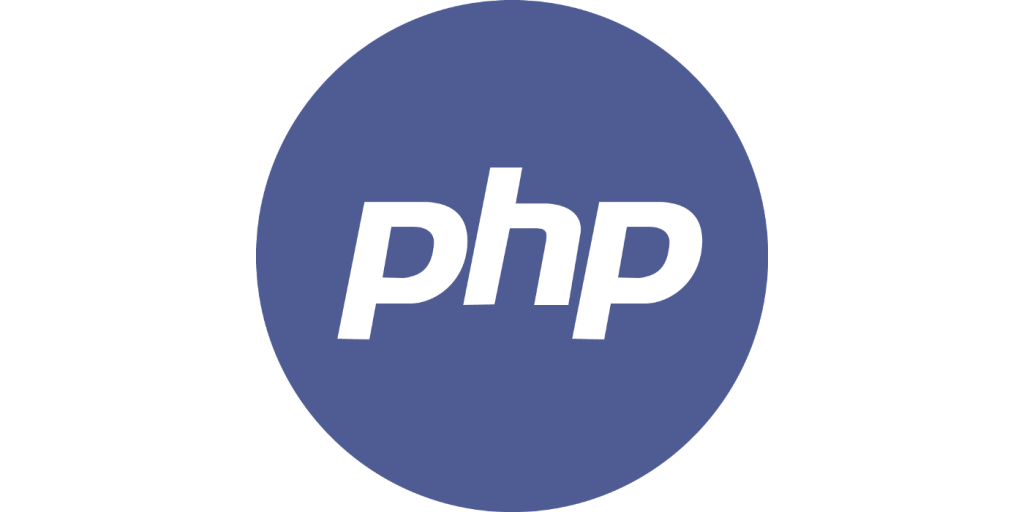
What is PHP?
PHP stands for Hypertext Preprocessor. PHP is a server-side scripting language that is primarily used for web development. It is an open-source language that can be embedded into HTML and is executed on the server side. Therefore, it is used to develop web applications.
PHP was created by Rasmus Lerdorf in 1994 but appeared in the market in 1995. PHP 7.4.0 is the latest version of PHP, which was released on 28 November.
What is top use cases of PHP?
Top use cases of PHP:
- Web Development: PHP is mainly used for building dynamic websites and web applications. It can handle form data, interact with databases, and generate dynamic content on the fly.
- Content Management Systems (CMS): Many popular CMS platforms like WordPress, Joomla, and Drupal are built using PHP, making it easier to create and manage website content.
- E-commerce Websites: PHP is commonly used to develop online shopping websites and integrate payment gateways for secure transactions.
- Web Services and APIs: PHP can be used to create RESTful APIs and web services to allow communication between different applications and systems.
- Social Media Applications: PHP is utilized to build social networking platforms, forums, and community-driven websites.
- Data Processing: PHP can handle data processing tasks, such as form submissions, file uploads, and data manipulation.
- Real-time Applications: Though not as common as other languages, PHP can be used to build real-time applications using technologies like WebSockets.
What are feature of PHP?
Features of PHP:-
- Open Source: An open-source language, which means it’s free to use, distribute, and modify.
- Easy to Learn: It has a simple syntax that is similar to C and Perl.
- Platform Independent: Which means it can run on different operating systems, such as Windows, Linux, and macOS.
- Integration with Other Technologies: PHP can be easily integrated with other technologies, such as HTML, CSS, JavaScript, and databases like MySQL, PostgreSQL, and Oracle.
- Object-Oriented Programming (OOP): PHP supports object-oriented programming (OOP) concepts such as encapsulation, inheritance, and polymorphism.
- Scalability: PHP is highly scalable, which means it can handle large applications with ease.
- Security: PHP has built-in security features to prevent attacks like SQL injection and cross-site scripting (XSS).
- Large Community Support: PHP has a large community of developers who contribute to its development, documentation, and support.
- Fast Execution: PHP is optimized for web development, and it’s designed to execute quickly and efficiently on web servers.
What is the workflow of PHP?
The workflow of PHP is as follows:
- The user requests a web page from the server.
- The server executes the PHP code on the web page.
- The PHP code generates the HTML output for the web page.
- The server sends the HTML output to the user’s browser.
- The user’s browser renders the HTML output and displays the web page to the user.
PHP works by first receiving a request from the user’s browser. The request is then sent to the server, where the PHP code is executed. The PHP code generates the HTML output for the web page, which is then sent back to the user’s browser. The user’s browser then renders the HTML output and displays the web page to the user.
How PHP Works & Architecture?
PHP works as a server-side scripting language, which means it runs on the web server and is responsible for generating dynamic content that is sent to the client’s web browser. Let’s explore the architecture and how PHP works step by step:
Step 1: The client requests the webpage on the browser.

Step 2: After receiving the client’s request, the server (where PHP software is installed) checks for the presence of the .php file associated with the request.

Step 3: When a file is found, it is sent to the PHP interpreter, as PHP is an interpreted language. The interpreter then checks for the requested data in the database.
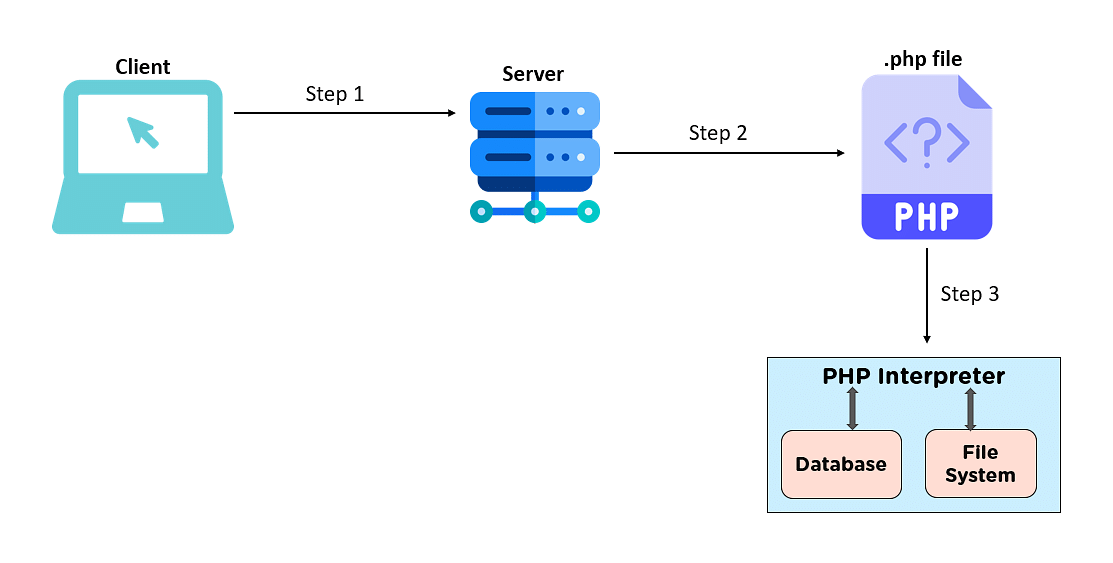
Step 4: The interpreter takes the requested data and sends it back as an HTML webpage because web browsers can’t understand .php files.
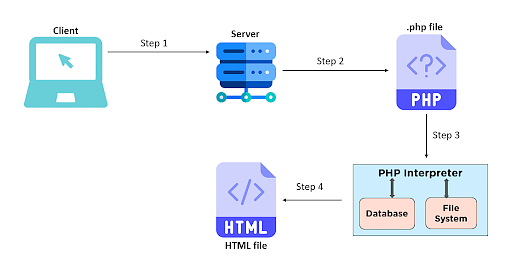
Step 5: The web server receives the HTML file from the interpreter.
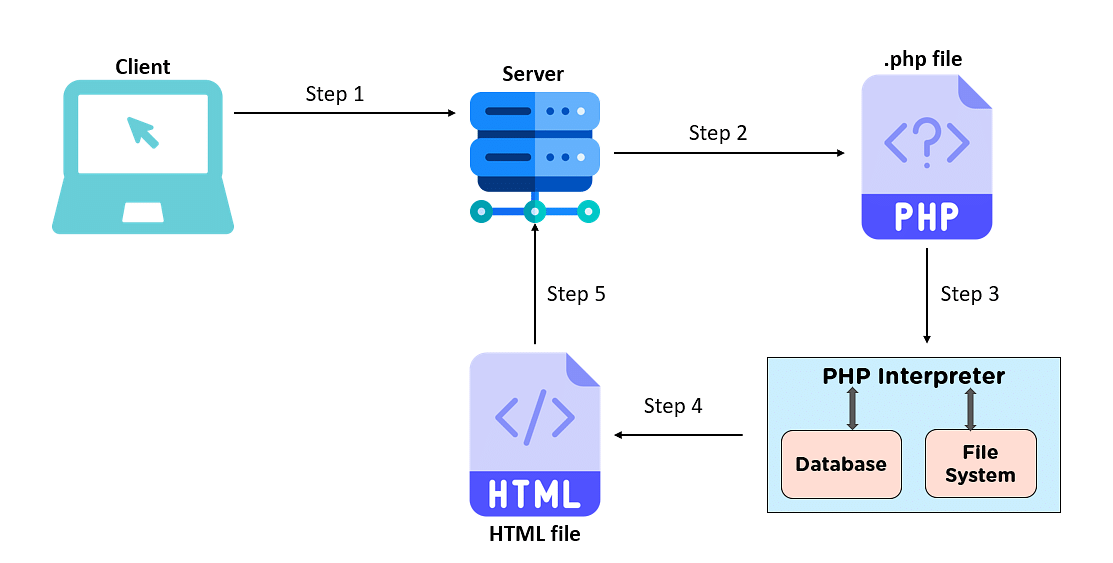
Step 6: And it sends the webpage back to the browser.
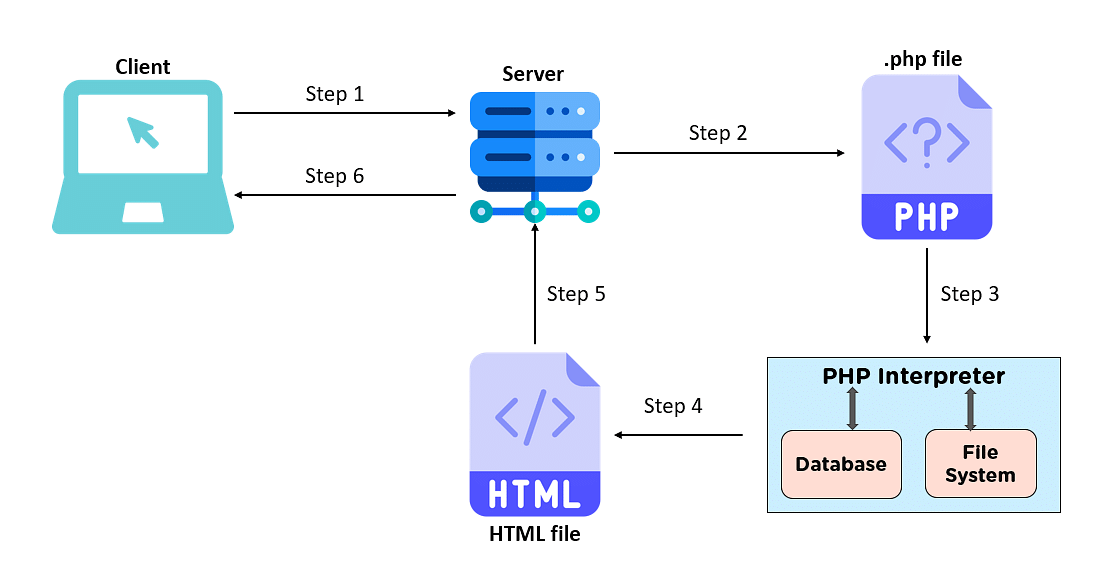
How to Install and Configure PHP?
The installation process for PHP varies depending on the operating system and web server you are using. Here’s a general outline of the steps:
Step 1: Download PHP
- Visit the official PHP website (https://www.php.net/downloads) and download the PHP installer for your OS.
Step 2: Install PHP
- Follow the installation instructions provided for your OS and web server. For example, on Windows, you might need to run the installer and follow the setup wizard.
Step 3: Configure PHP (optional)
- After installing PHP, you can configure it by modifying the “php.ini” file to suit your needs. This file contains various settings for PHP, such as error reporting, file upload limits, and more.
Step 4: Test PHP
- Create a simple PHP file, e.g., “test.php,” containing the following code:
<?php
phpinfo();
?>
- Save the file and place it in your web server’s document root directory.
- Open a web browser and access the file using the URL (e.g., http://localhost/test.php).
- If PHP is correctly installed and configured, you should see a page displaying PHP configuration information.
Step by Step Tutorials for PHP for hello world program
To create a hello world program in PHP, you can follow these steps:
- Create a new file and save it as hello.php.
- In the hello.php file, add the following code:
PHP
<!DOCTYPE html>
<html lang="en">
<head>
<meta charset="UTF-8">
<meta name="viewport" content="width=device-width, initial-scale=1.0">
<title>PHP - Hello, World!</title>
</head>
<body>
<h1>Hello, World!</h1>
</body>
</html>- Save the hello.php file.
- Open the hello.php file in a web browser.
- You should see the message “Hello, world!” displayed in the web browser.